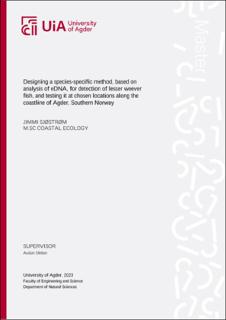| dc.description.abstract | Temperature is largely influencing species dispersion, and when the temperature conditions within an area are changing, species populations often respond by moving to other, more suitable areas. Such behavior has often been observed in marine species, because of increased water temperatures in the ocean. Throughout the Northeastern Atlantic Ocean, including the North Sea and Skagerrak, increased water temperatures have been registered over the last three decades, which are likely to have affected the availability of suitable habitats for various fish species, and therefore their local presence. This could explain how the warm water fish species lesser weever, Echiichthys vipera, over the past few years have been registered in Norwegian waters for the first time. The species is mostly known for its painful and venomous stings, while relatively little is known about its life cycle or ecological importance. Studying marine species within their natural environment is generally considered challenging since they are “less visible” than terrestrial species. However, utilization of molecular methods for faster and more precise species detection can ease future research.
In this study a species-specific method, based on analysis of environmental DNA (eDNA), has been designed for detection of lesser weever fish. The eDNA was sampled at chosen locations along the Agder coast, and was analysed using real-time PCR with primers and a TaqMan probe designed to amplify only DNA from this species. The analysis results show that lesser weever DNA was successfully detected in four locations despite very low concentrations. This proves that the designed method is good, and that the sensitivity is high. The high sensitivity was also shown using serial dilutions of genomic DNA, while the specificity was ensured through an in-silico PCR, and by testing the primers and probe on the closely related species greater weever. Generally, for the aim of detecting the potential presence of a species in a chosen location, independent on abundance, the impression of this method has a high utility and efficiency. | |
